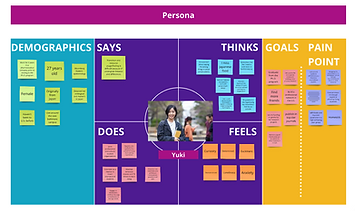
Improving Orientation Experiences at Johns Hopkins University
Using mixed-methods research to improve student orientation experience and foster collaboration across programs
Background & The Problem
Starting at a new university is both exciting and daunting, and at Johns Hopkins University, students consistently reported that orientation felt overwhelming. Students shared that they were bombarded with information at the beginning, making it difficult to retain key details.
Weeks into the semester, they often forgot where to find essential resources and wished for a more structured way to access information over time rather than receiving everything at once.
Recognizing this challenge, we launched a project to redesign the student orientation experience - with the goal of pacing information delivery, aligning resources with real-time student needs, and ensuring a seamless transition throughout the semester.
The Approach
Understanding the Current Student Journey
To deeply understand the student experience, we conducted 30+ student interviews and two focus group sessions, spanning multiple schools and programs. Our research aimed to:
-
Identify common pain points in the current orientation experience.
-
Compare onboarding differences across various programs.
-
Explore student perspectives on how orientation could be improved.

Expanding Research with a Diary Study
Beyond interviews and focus groups, I also implemented a diary study, tracking:
-
Students’ emotions throughout the academic year.
-
Key challenges they faced as the semester went along.
-
Resources they needed most at different stages.
By structuring our research to align with the semester timeline, we uncovered critical insights about when and how students actually needed information rather than just what they were given upfront.



Complement Insights with Survey Data
Because JHU has a large and diverse student body, we aimed to capture a comprehensive understanding of the orientation experience. To complement our qualitative research with quantitative insights, I proposed incorporating survey data.
Therefore, we reached out to program advisors, who collected student feedback through surveys immediately after orientation. By analyzing these survey results, we were able to validate our findings, identify key trends, and strengthen our recommendations with data-driven insights.
Where Orientation Falls Short:
Mapping the Current vs. Ideal Student Journey

User Persona

User Persona

User Journey Mapping - Current State

User Journey Mapping - Ideal State
Our research revealed four major gaps in the current onboarding experience:
Information Overload & Lack of a Centralized Hub: The Orientation was too long, with students retaining only less than 50% of the information and no centralized repository for later reference.
The Power of Early Social Connections: Students who built peer networks before arrival had a much smoother transition.
Challenges for International Students: Visa logistics, housing, SIM cards, and other essentials were major hurdles for international students.
Prototyping & Testing: Making the Solution a Reality
I designed a timeline-based orientation module within the university app, ensuring students receive the right resources at the right time throughout their transition.




With the design finalized in Figma, I am now in the usability testing phase, gathering student feedback to refine the modules and optimize how information is structured and delivered.

The Impact
1. Platform Enhancements: Established a scalable framework for onboarding, ensuring future iterations of orientation are data-driven and student-centered.
2. University-Wide Awareness: Presented our research and solutions at the Digital Student Experience Conference at Hopkins, sharing findings with other departments.
Lessons Learned
1. Bridging Research and Execution: Translating research insights into a tangible, usable product required continuous iteration, stakeholder buy-in, and a structured implementation plan.
2. Cross-Departmental Collaboration is Essential: Improving the student experience meant aligning multiple stakeholders, including faculty, administrators, IT teams, and student services. Navigating different priorities and ensuring buy-in from all sides was a critical part of the process.
3. Designing for Scalability: With JHU’s large and diverse student body, it was important to create a solution that was flexible enough to accommodate different programs and student needs while maintaining a unified experience.
